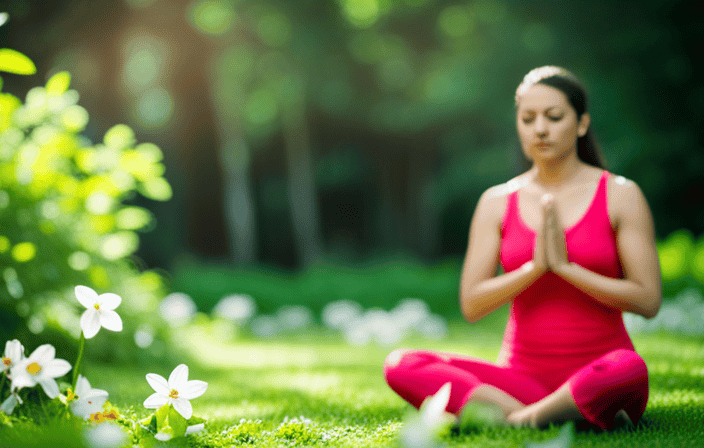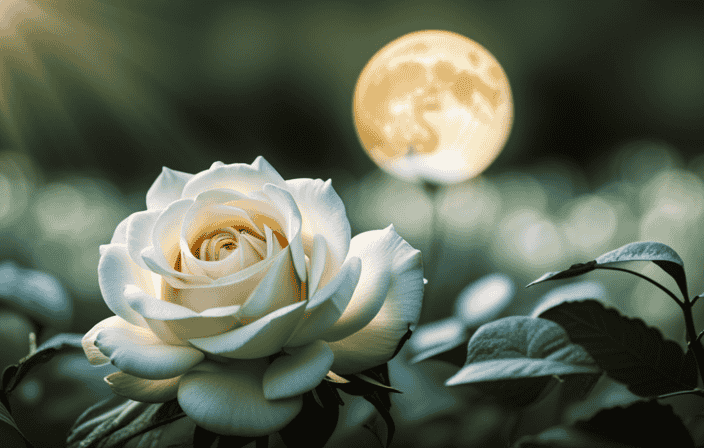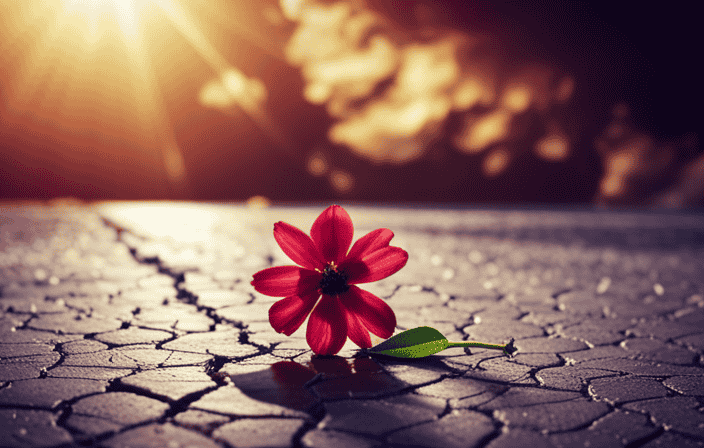Meditation
Enhancing Well-Being: The Power Of Spiritual Cleansing

Improving our overall well-being is an endeavor that necessitates us to explore deeper than what meets the eye, venturing into the core of our essence. It’s a search for spiritual balance, an aim for tranquility that transcends just our physical condition.
In this article, we explore the power of spiritual cleansing, a practice that can transform our lives by purging negative energy and restoring balance to our mind, body, and spirit.
Join me as we embark on a transformative journey towards enhanced well-being through the profound art of spiritual cleansing.
Key Takeaways
- Setting intentions enhances the effectiveness of spiritual cleansing and fosters a deeper connection with the divine.
- Different methods of spiritual cleansing, such as smudging, taking a sea salt bath, meditating, visualization, and energy healing, can be used to remove negative energy and promote balance, clarity, and peace.
- Spiritual cleansing can be incorporated into daily life through practices like meditation, setting intentions daily, practicing gratitude, using positive affirmations, and clearing the mind of clutter.
- Trusting your instincts and recognizing when a spiritual cleansing is needed, as well as performing spiritual cleansing on others with their consent and support, can contribute to overall well-being.
What is it?
Spiritual cleansing is a practice that I incorporate into my daily life to remove negative energy from my mind, body, and spirit. I use methods such as smudging, bathing, and meditation. It is a powerful tool that allows me to reset my energy fields and restore balance in my mental and physical well-being.
By setting clear intentions and focusing on positive thoughts and feelings, I am able to enhance the effectiveness of the cleansing ritual. This practice not only promotes clarity and peace but also strengthens my spiritual connection and improves my overall health.
It is a way for me to release any lingering negativity and embrace positivity. Spiritual cleansing has become an essential part of my routine, helping me to maintain a sense of balance, clarity, and well-being in my life.
Importance of Intentions
Setting clear intentions allows me to guide the energy of the process and deepen my connection with the divine. When I set my intentions, I am able to amplify the energy of the cleansing ritual and enhance its effectiveness. It sets the tone for the entire process and reinforces my intentions throughout the day. It is like a compass that guides me towards balance, clarity, and peace.
To help you understand the importance of intentions, let me share a table that illustrates the power of intentions in our lives:
| Without Clear Intentions | With Clear Intentions |
|---|---|
| Feeling lost and disconnected | Feeling grounded and connected |
| Lack of focus and direction | Clarity and purpose |
| Negativity and self-doubt | Positivity and self-belief |
| Chaos and imbalance | Harmony and balance |
By setting clear intentions, we can transform our lives and enhance our well-being. So, take a moment to set your intentions and watch as the energy of the universe aligns with your desires. Remember, the power is within you.
Different Methods
I prefer to explore various methods of cleansing. Such as smudging with sage, taking a sea salt bath, meditating, visualizing, and energy healing. Each method offers its own unique benefits and resonates with different individuals.
Smudging with sage has been used for centuries to clear negative energies and restore balance.
Taking a sea salt bath not only cleanses the physical body but also helps to release emotional and energetic toxins.
Meditating allows me to quiet the mind, connect with my inner self, and release any stagnant energy.
Visualizing helps me to manifest my intentions and create positive energy in my surroundings.
Finally, energy healing techniques like Reiki or sound therapy can help to rebalance and align the energy centers in the body.
By exploring these different methods, I can find what works best for me and enhance my overall well-being.
Performing on Others
Exploring different methods of spiritual cleansing has allowed me to offer assistance to others in their journey towards balance and peace.
When performing spiritual cleansing on others, it is crucial to always seek their consent and approach the process with respect and sensitivity. Before starting, I make sure to ground myself, center my energy, and create a protective space.
I offer my support and guidance throughout the cleansing, respecting their boundaries and preferences. I understand that everyone’s spiritual journey is unique, and I am there to assist them in finding their own path to well-being.
Witnessing the transformation and the release of negative energy in others is truly inspiring. It reminds me of the power of spiritual cleansing and the profound impact it can have on one’s overall well-being.
Frequency of Cleansing
When determining the frequency of my personal cleansing, I trust my intuition and recognize when I am feeling weighed down, stressed, or disconnected. It’s important to listen to our inner selves and acknowledge when we need to release negative energy and restore balance.
Each individual is unique, and the need for spiritual cleansing may vary.
Here are 3 key factors to consider when deciding how often to cleanse:
-
Intuition: Trust your instincts and inner guidance. Your intuition will let you know when it’s time for a cleanse.
-
Energy Levels: Pay attention to your energy levels. If you feel drained or overwhelmed, it may be a sign that a cleansing is needed to reset and recharge.
-
External Influences: Consider the external factors that can affect your energy, such as stressful situations or negative environments. Cleansing more frequently in challenging times can help maintain your well-being.
Remember, the goal is to promote balance, clarity, and peace. Listen to your inner wisdom and cleanse as necessary to enhance your overall well-being. Trust the process and embrace the power of spiritual cleansing.
Incorporating into Daily Life
Incorporating spiritual cleansing into my daily life is like adding a splash of clarity and peace to my everyday routine. It allows me to start each day with a refreshed mind, body, and spirit.
As I practice meditation and set my intentions daily, I create a sacred space within myself that is filled with positive energy. By practicing gratitude and using positive affirmations, I clear my mind of clutter and increase positivity throughout the day.
This daily ritual not only enhances my overall well-being but also strengthens my spiritual connection. It reminds me to stay grounded, centered, and protected, which is crucial in navigating life’s challenges.
Incorporating spiritual cleansing into my daily life empowers me to embrace the power of healing and transformation, and it fills my days with a sense of purpose and joy.
Benefits of Cleansing
Experiencing the benefits of daily spiritual cleansing brings a sense of balance, clarity, and peace into my life. It is truly remarkable how this practice resets my energy fields and restores my mental and physical equilibrium.
Through spiritual cleansing, I am able to remove negative energy from my mind, body, and spirit, allowing me to embrace positivity and enhance my overall well-being. The daily ritual promotes a deep connection with the divine, amplifying the energy of the cleansing process and fostering a sense of inner calm.
It is through setting my intentions and visualizing desired outcomes that I am able to guide the energy of the cleansing, and throughout the day, my affirmations reinforce these intentions. By incorporating spiritual cleansing into my daily life, I am able to clear my mind of clutter, increase positivity, and truly embrace the power of well-being.
Setting Intentions
Setting my intentions before spiritual cleansing helps me align with positive energy and deepen my connection with the divine. By setting a clear intention, I am able to guide the energy of the cleansing process and amplify its effectiveness. Visualizing my desired outcomes during the ritual enhances the energy and brings me closer to my spiritual goals. Throughout the day, I reinforce my intentions with daily affirmations, reminding myself of the positive energy I want to invite into my life.
When I set my intentions before spiritual cleansing, I enter the process with a focused and positive mindset. This allows me to fully embrace the cleansing ritual and experience its transformative effects. By consciously directing my thoughts and feelings towards positivity, I am able to release any lingering negative energy and restore balance, clarity, and peace within myself.
Setting intentions is a powerful practice that not only enhances the spiritual cleansing process but also carries over into other aspects of my life. It helps me to stay grounded, aligned, and connected with my higher self. By setting intentions daily, I am able to cultivate a more mindful and purposeful life, and I am better able to attract and manifest the positive energy and experiences that I desire.
In conclusion, setting intentions before spiritual cleansing is a vital step in enhancing my well-being. It allows me to align with positive energy, deepen my connection with the divine, and manifest the positive outcomes I desire. By consciously directing my thoughts and feelings, I am able to experience the transformative power of spiritual cleansing and create a more balanced and peaceful life.
Performing the Ritual
Now that we have set our intentions, it is time to dive into the process of performing the spiritual cleansing ritual. This is where we actively engage with the energy and connect with the divine. By following the chosen method, whether it’s smudging, bathing, visualization, or meditation, we allow ourselves to release any negative energy and invite in positivity and peace.
To give you a clearer picture, let me present a visual representation of the steps involved in performing the ritual:
| Step | Actions |
|---|---|
| 1 | Set intention and focus on positive thoughts and feelings |
| 2 | Choose a suitable method for cleansing |
| 3 | Relax the mind before starting the process |
| 4 | Follow the chosen method step by step |
As we move through each step, it is important to be intentional and thoughtful. By doing so, we create a sacred space for the cleansing to take place. So, let’s embark on this journey of purification and renewal, knowing that we are taking an active role in enhancing our well-being.
Closing the Ceremony
To conclude the ceremony, I express gratitude to the universe for its assistance. I release any remaining negative energy and visualize sealing my personal energy. I then close down the sacred space and ground myself to embrace positivity.
It is important to acknowledge and appreciate the divine guidance and support that has been present throughout the spiritual cleansing process. By expressing gratitude, we honor the energy that has helped us in removing negativity and restoring balance.
As I release any lingering negative energy, I let go of any attachments or burdens that no longer serve me. Visualizing the sealing of my personal energy allows me to create a protective barrier, ensuring that only positivity and light can enter.
Closing down the sacred space signifies the completion of the ritual, bringing a sense of closure and finality. Finally, grounding myself helps me to connect with the earth’s energy and embrace the positivity and well-being that spiritual cleansing brings.
Key Facts
Closing the ceremony with gratitude and releasing any remaining negative energy are important steps in spiritual cleansing. Expressing gratitude to the universe for its assistance acknowledges the divine support received throughout the cleansing process. It allows us to cultivate a sense of appreciation and connection to the greater spiritual forces at work. Releasing any lingering negative energy ensures that we are not carrying it with us after the cleansing ritual. This step is essential for maintaining the balance, clarity, and peace that spiritual cleansing brings. By visualizing the sealing of our personal energy and closing down any sacred space created during the cleansing, we create a sense of completion and protection. Grounding ourselves afterwards helps us embrace positivity and integrate the benefits of the cleansing into our daily lives.
| Key Facts about Spiritual Cleansing |
|---|
| – Spiritual cleansing removes negative energy from mind, body, and spirit |
| – Various methods include smudging, bathing, and meditation |
| – Often performed before and after rituals or spell work |
| – Setting intentions and being mindful during the process is important |
| – Spiritual cleansing promotes balance, clarity, and peace |
Frequently Asked Questions
Can spiritual cleansing be done remotely or does it have to be done in person?
Oh, the wonders of spiritual cleansing! It’s amazing how it can be done remotely or in person. Energy knows no boundaries, after all. So go ahead, cleanse away, wherever you may be.
Are there any specific tools or materials needed for spiritual cleansing?
For spiritual cleansing, specific tools or materials are not always necessary. However, some common methods may require items like sage for smudging or sea salt for bathing. Ultimately, it’s about intention and connecting with the divine energy within.
How long does a typical spiritual cleansing ritual take to complete?
A typical spiritual cleansing ritual can vary in length, depending on the chosen method and personal preference. It can range from a few minutes to an hour or more. The important thing is to take the time needed to perform the ritual intentionally and thoughtfully.
Can spiritual cleansing help with specific emotional or mental challenges, such as anxiety or depression?
Yes, spiritual cleansing can help with specific emotional or mental challenges like anxiety or depression. By removing negative energy and promoting balance, clarity, and peace, it can reset your energy fields and restore mental and physical balance, enhancing overall well-being.
Is it necessary to have a specific belief system or religious affiliation to benefit from spiritual cleansing?
No, it is not necessary to have a specific belief system or religious affiliation to benefit from spiritual cleansing. It is a personal practice that can be adapted to fit one’s individual beliefs and needs.
Conclusion
In conclusion, spiritual cleansing is a magical practice that brings a sense of balance and clarity to our lives. By setting clear intentions and embracing different methods, we can enhance our overall well-being and connect with the divine.
Whether it’s smudging, bathing, or meditating, each cleansing ritual is a sacred journey towards inner peace. Remember, the frequency of cleansing is unique to each individual, so trust your intuition and listen to your needs.
By incorporating spiritual cleansing into our daily lives, we can embrace positivity and create a harmonious environment for ourselves and others. Embrace the power of spiritual cleansing and watch your spirit soar.
Meet Kalinda, the passionate and visionary Editor-in-Chief of OurMindAndBody.com. Kalinda is a beacon of light in the realm of holistic well-being, and her mission is to positively impact the lives of others by inspiring them to embrace a healthier and more fulfilling lifestyle.
With a deep-rooted love for meditation, yoga, and spirituality, Kalinda’s journey toward self-discovery and personal growth started at a young age. She found solace and strength in these practices, which not only helped her cope with the challenges of life but also provided her with a profound sense of purpose. Eager to share the transformative power of these ancient disciplines, Kalinda embarked on a path to spread awareness and understanding.
Meditation
Unveiling The Mysteries Of Tantric Meditation
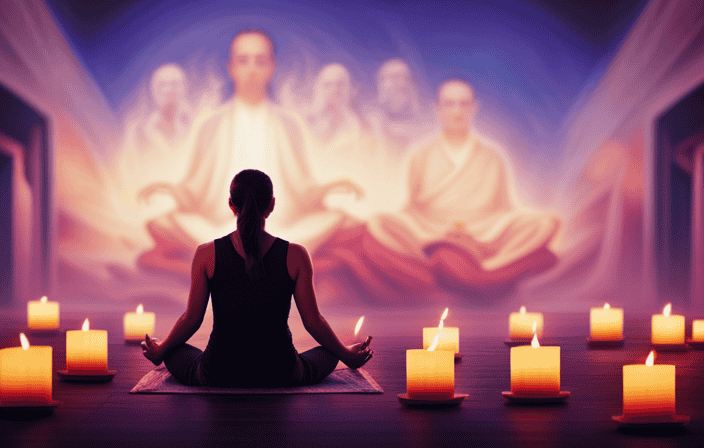
Enter the world of tantric meditation, where the enigmas of the mind and body blend together in a graceful dance.
Like a hidden treasure waiting to be discovered, this ancient practice unveils a path to deep connection and profound transformation.
Through sacred positions and nurturing practices, tantric meditation invites us to explore the depths of our being, embracing our desires and harnessing our sexual energy for spiritual awakening.
Join me on this journey as we unravel the secrets and unlock the power of tantric meditation.
Key Takeaways
- Tantric meditation integrates spirituality, mindfulness, and sexuality.
- It recognizes sexual energy as sacred and transformative.
- Trust, openness, and vulnerability are essential for tantric meditation.
- The practice cultivates deep connection, intimacy, and personal growth.
What is it?
I can explain what tantric meditation is in the context of the pre-existing knowledge.
Tantric meditation is a practice that integrates spirituality, mindfulness, and sexuality, taking a holistic approach to the human experience. It embraces our physical desires and sensory experiences, recognizing sexual energy as sacred and transformative.
What sets tantric meditation apart is its emphasis on connection and intimacy with oneself and others. It goes beyond traditional meditation practices by incorporating the exploration of our deepest desires and the cultivation of a deep sense of connection and trust.
Tantric meditation can be practiced individually or with a partner, and it is not limited to any specific religious tradition. It is a practice that invites us to approach our spirituality and sexuality with openness, respect, and a willingness to explore and grow.
Practices and Positions
A variety of positions and practices can be utilized in tantric meditation to foster trust, openness, and vulnerability while deepening connections with oneself and others. These practices are designed to create a safe and supportive environment for spiritual evolution.
Here are three key positions and practices commonly used in tantric meditation:
-
Nurturing Meditation: Sit facing your partner, place your hands on each other’s hearts, make eye contact, and synchronize your breath. This practice promotes a sense of deep connection and intimacy.
-
Yab-Yum or Lotus: In this position, one partner sits in the lap of the other, maintaining eye contact. This symbolizes the union of energies and fosters a sense of unity and harmony.
-
Hands On Hearts: Sit facing your partner, place your hands on each other’s hearts, make eye contact, and focus on the energy flowing between you. This practice cultivates trust, openness, and vulnerability.
These positions and practices can be adapted based on comfort and preferences, allowing individuals to explore and deepen their spiritual connection in a way that feels authentic to them.
Unique Characteristics
Integrating spirituality, mindfulness, and sexuality, tantric meditation offers a holistic approach to human experience. Unlike other forms of meditation, tantric meditation embraces our physical desires and sensory experiences, recognizing sexual energy as sacred and transformative. It emphasizes the importance of connection and intimacy with oneself and others, allowing us to explore the depths of our being.
By integrating our spirituality, mindfulness, and sexuality, we can tap into a profound sense of self-discovery and personal growth. Tantric meditation promotes mindfulness and connection with the divine, allowing us to harness our sexual energy for spiritual transformation. This unique practice fosters a holistic approach to spiritual awakening, inviting us to explore the depths of our desires and emotions, and ultimately leading us to a more profound sense of connection and fulfillment.
FAQs and General Information
One important aspect of tantric meditation is that it can be practiced individually, not just by couples. This means that anyone, regardless of their relationship status, can experience the transformative power of tantric meditation.
Here are some frequently asked questions and general information about tantric meditation:
-
Is tantric meditation only about sexuality?
- No, tantric meditation integrates spirituality, mindfulness, and sexuality. It takes a holistic approach to the human experience, recognizing the sacredness and transformative nature of sexual energy.
-
Is tantric meditation limited to specific religions?
- No, tantric meditation can be found in various traditions and is not exclusive to Hinduism and Buddhism. It is a practice that can be adapted and practiced by anyone with respect and openness.
-
Can tantric meditation be combined with other spiritual practices?
- Yes, tantric meditation can be combined with other forms of meditation or spiritual practices. It is a versatile practice that can enhance and complement other spiritual journeys.
-
Do I need to have a partner to practice tantric meditation?
- No, tantric meditation can be practiced individually. While some positions and practices involve a partner, there are also solo practices that allow for deepening connection and intimacy with oneself.
Importance of Trust
Trust is an essential component of tantric practice as it allows for deepening connection and exploration. When engaging in tantric meditation, trust creates a safe and supportive environment for spiritual evolution. It is the foundation upon which profound intimacy and vulnerability can be built. Trust allows us to let go of inhibitions, fears, and doubts, enabling us to fully surrender to the experience.
It is through trust that we can open ourselves up to the transformative power of tantric meditation. By trusting ourselves and our partners, we create a space where authenticity and acceptance thrive. Trust fosters a sense of security, allowing us to explore our desires and boundaries without judgment.
It is through trust that we can truly connect with ourselves, others, and the divine, unlocking the mysteries and experiencing the profound benefits of tantric meditation.
Benefits and Goals
Enhancing self-discovery and personal growth through tantric practices and meditation is a profound goal. By embracing the holistic approach of tantric meditation, we can unlock a wealth of benefits and achieve our highest potential.
Here are three key ways in which tantric meditation can enrich our lives:
-
Deep Connection and Intimacy: Through tantric practices, we can cultivate a profound sense of connection and intimacy with ourselves and others. By embracing our physical desires and sensory experiences, we can create a space for deepening our relationships and fostering genuine connections.
-
Spiritual Transformation: Tantric meditation harnesses the power of sexual energy to facilitate spiritual transformation. By recognizing sexual energy as sacred and transformative, we can tap into its immense potential for personal growth and spiritual evolution.
-
Mindfulness and Divine Connection: Tantric meditation promotes mindfulness and enhances our connection with the divine. By integrating spirituality and mindfulness into our practice, we can cultivate a deeper awareness of ourselves and our connection to the world around us.
In conclusion, tantric meditation offers a unique pathway to self-discovery, personal growth, and spiritual awakening. By embracing its teachings and practices, we can embark on a transformative journey towards greater fulfillment and enlightenment.
Integration with Other Practices
Now that we have explored the benefits and goals of tantric meditation, let’s delve into the fascinating way in which it can be integrated with other practices. Tantric meditation is not limited to being practiced in isolation, but can be combined with various spiritual and meditative techniques to deepen and enhance our experience. By integrating tantric meditation with other practices, we can tap into different aspects of our being and open ourselves up to new dimensions of growth and transformation.
To illustrate the possibilities, let’s consider a 3-column table that showcases some examples of how tantric meditation can be integrated with other practices:
| Practice | Description | Benefits |
|---|---|---|
| Yoga | Combining tantric meditation with yoga asanas can enhance body awareness and energy flow, promoting physical and spiritual health. | Increased flexibility, improved focus, and heightened spiritual connection. |
| Breathwork | Incorporating breathwork techniques with tantric meditation can deepen the connection to our life force energy, intensify sensations, and expand consciousness. | Enhanced breath control, increased energy flow, and expanded states of awareness. |
| Sound Healing | Integrating sound healing practices, such as chanting or listening to sacred music, with tantric meditation can amplify the vibrational energy and facilitate deeper states of relaxation and spiritual connection. | Heightened sense of peace, harmonized energy centers, and enhanced spiritual experiences. |
By integrating tantric meditation with other practices, we can explore new dimensions of our being, deepen our spiritual connection, and expand our personal growth and transformation. It is a beautiful way to create a holistic approach to our spiritual awakening.
Creating a Safe Environment
To ensure a safe environment for practicing tantric meditation, it is important to establish clear boundaries and communicate openly with oneself and others. This means being aware of personal limits and expressing them honestly.
It also involves actively listening to the needs and desires of your partner or partners, and respecting their boundaries as well. Creating a safe space requires trust, openness, and vulnerability, where everyone feels comfortable and supported.
It is essential to have open and honest conversations about consent, desires, and intentions before engaging in any tantric practices. This allows for a deeper level of connection and understanding, fostering a sense of safety and security.
By creating this safe environment, we can fully explore the transformative power of tantric meditation and experience profound spiritual growth.
Frequently Asked Questions
How can tantric meditation be integrated with other forms of meditation or spiritual practices?
To integrate tantric meditation with other forms of meditation or spiritual practices, one can incorporate tantric principles like mindfulness, connection, and embracing physical desires into their existing practice. This can deepen the experience and bring a more holistic approach to spiritual growth.
Can tantric meditation be practiced by individuals who are not in a romantic relationship?
Absolutely! Tantric meditation can be practiced by individuals who are not in a romantic relationship. It is a beautiful path of self-discovery, personal growth, and spiritual transformation that can be embraced by anyone with openness and respect.
Is tantric meditation limited to Hinduism and Buddhism, or is it found in other traditions as well?
Tantric meditation is not limited to Hinduism and Buddhism, as it can be found in various traditions. It is a practice that can be embraced by anyone with respect and openness, regardless of their religious or spiritual background.
What are some specific techniques or exercises that can be practiced during tantric meditation?
During tantric meditation, specific techniques and exercises can be practiced to deepen connection and intimacy. These include nurturing meditation, yab-yum or lotus position, and hands on hearts. These practices foster trust, openness, and vulnerability.
How does tantric meditation specifically harness and transform sexual energy for spiritual purposes?
Tantric meditation harnesses and transforms sexual energy for spiritual purposes by recognizing it as sacred and transformative. Through practices such as breathwork, visualization, and mindfulness, sexual energy is channeled and directed towards spiritual growth, self-discovery, and deepening connection with oneself and others.
Meet Nadi, the soulful writer and explorer of inner realms who graces OurMindAndBody.com with her profound insights and heartfelt wisdom. With a profound passion for mindfulness, meditation, and spiritual growth, Nadi weaves words that touch the hearts and minds of readers, leaving a lasting impact on their well-being journey.
Rooted in a background of philosophy and psychology, Nadi’s curiosity about the human mind and the mysteries of the soul led her on a transformative path of self-discovery. Drawn to the transformative power of mindfulness and meditation, she embarked on a quest to understand the intricacies of these practices, not only for her own growth but also to inspire others to embark on their own inner journeys.
Meditation
Unlocking The Power Of Flower Energy In Meditation
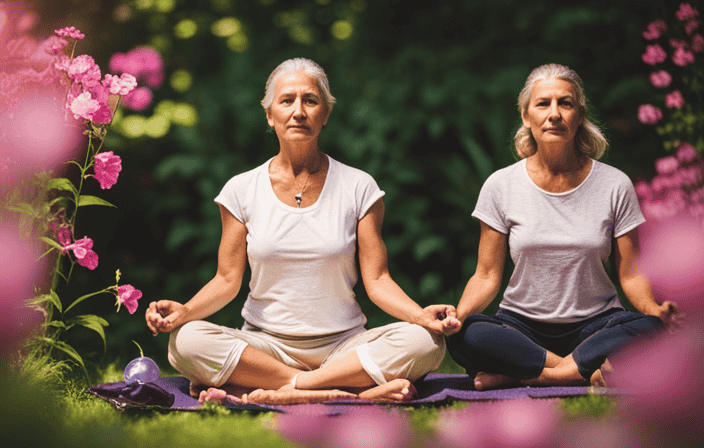
Similar to a fragile flower blossoming under the gentle caress of sunlight, flower meditation enables us to tap into the unseen potential of nature’s energy that lies within us.
In this article, we will explore the transformative benefits of flower meditation, from reducing stress and anxiety to fostering a deep connection with the natural world.
Through this practice, we can align our mind, body, and spirit, bringing peace and tranquility into our lives.
Join me on this spiritual journey as we discover the profound effects of harnessing the power of flower energy in meditation.
Key Takeaways
- Flower meditation heightens self-awareness.
- Engaging with flowers reduces stress, anxiety, and tension.
- Flower meditation fosters a connection with nature.
- Flower energy aligns the mind, body, and spirit.
What is it?
Flower meditation is a practice that I can incorporate into my daily life to unlock the power of flower energy and enhance my overall well-being.
It is a beautiful and calming practice that allows me to connect with nature on a deeper level. By focusing my attention on the intricate details of a flower, I become more present and mindful.
This practice heightens my self-awareness and brings clarity to my thoughts and emotions. The soothing effect of flowers helps me to reduce stress, anxiety, and tension. As I engage with the energy of flowers, I feel a sense of peace and tranquility wash over me.
Flower meditation aligns my mind, body, and spirit, creating a harmonious balance within me. It is a practice that nourishes and revitalizes my being, leaving me feeling more connected and alive.
Benefits of Flower Meditation
Engaging in this practice heightens my self-awareness and promotes living with intention. Flower meditation allows me to focus on the present moment, cultivating mindfulness and bringing clarity to my conscious choices. The soothing effect of flowers on my mind and body reduces stress, anxiety, and tension, promoting relaxation and a sense of peace.
Through flower meditation, I foster a deep connection with nature, immersing myself in the beauty of flowers and developing an appreciation for the natural world. This practice also encourages environmental consciousness, reminding me of my relationship with the Earth and the importance of mindfulness towards it.
Furthermore, flower energy aligns my mind, body, and spirit, creating balance and enhancing my holistic well-being. It merges with my personal energy, revitalizing me and improving my overall vitality.
Incorporating flower meditation into my daily life is simple. I display fresh flowers as a visual reminder of the present moment, take mindful walks in nature to observe flowers, create flower arrangements, and practice gratitude for the beauty of flowers and nature.
Flower meditation truly unlocks the power of flower energy, allowing me to experience a deeper connection with myself, nature, and the universe.
Connection with Nature
Immersing in the beauty of nature through this practice fosters a deep connection with the environment and cultivates an appreciation for its wonders.
Flower meditation encourages us to slow down and truly observe the intricate details and vibrant colors of the flowers around us.
As we take mindful walks in nature and observe the flowers, we become more aware of the interconnectedness of all living beings and the importance of preserving the natural world.
This awareness promotes environmental consciousness and a sense of responsibility towards the Earth.
The beauty and tranquility of flowers remind us to be grateful for the gifts of nature and to treat the Earth with respect and care.
Through flower meditation, we can deepen our connection with nature and find solace and inspiration in its ever-changing beauty.
Mind-Body-Spirit Connection
Through this practice, I feel a deep sense of alignment between my mind, body, and spirit.
As I engage in flower meditation, I am reminded of the interconnectedness of all aspects of my being.
The energy of the flowers merges with my own, creating a harmonious balance within me.
I become more aware of any imbalances or areas that need attention, allowing me to address them with compassion and kindness.
This connection between my mind, body, and spirit enhances my overall well-being and vitality.
I am able to tap into a profound sense of inner peace and clarity.
The flower energy acts as a gentle guide, leading me towards a higher level of consciousness and spiritual growth.
It is truly a transformative experience that nourishes my entire being.
Incorporating into Daily Life
Incorporating flower meditation into my daily life allows me to create a deeper connection with nature and cultivate a sense of mindfulness. Displaying fresh flowers in my home serves as a visual reminder to stay present and appreciate the beauty of the present moment.
Taking mindful walks in nature and observing the intricate details of flowers helps me to immerse myself in the natural world and develop a sense of gratitude for its wonders. I also enjoy creating flower arrangements and participating in floral crafts, which not only brings me joy but also allows me to express my creativity.
By practicing gratitude for the beauty of flowers and nature, I feel a profound sense of peace and tranquility. Flower meditation has truly become an integral part of my daily routine, bringing me closer to nature and enhancing my overall well-being.
Types of Flower Meditation
By exploring different techniques such as rose meditation and golden flower meditation, I have discovered new ways to deepen my spiritual practice and expand my consciousness.
Rose meditation has been a profound experience for me, as it allows me to tap into self-love, compassion, and emotional healing. Focusing on the delicate petals of a rose brings a sense of peace and acceptance into my being. It reminds me to be gentle with myself and others, fostering a deep connection with the world around me.
On the other hand, golden flower meditation has opened up a whole new realm of spiritual insights. Visualizing an imaginary golden flower within my body has helped me access higher levels of consciousness and awareness. It is a powerful practice that brings clarity and enlightenment to my journey.
Exploring these different types of flower meditation has truly transformed my spiritual path, allowing me to unlock the immense power of flower energy in my meditation practice.
Exploring different types of flower meditation has expanded my spiritual practice and deepened my connection to the world around me. Each type of flower meditation has its own unique energy and intention, allowing me to explore different aspects of myself and the universe.
-
Rose meditation: By focusing on a rose, I am reminded of the power of self-love and compassion. It brings forth emotions of tenderness and nurturance, allowing me to heal and grow emotionally.
-
Golden flower meditation: This practice takes me on a journey within, as I visualize an imaginary golden flower. It helps me tap into higher levels of consciousness and spiritual insights, guiding me towards profound awareness and enlightenment.
-
Nature immersion meditation: By simply observing flowers in nature, I am filled with awe and wonder. It reminds me of the interconnectedness of all living beings and the beauty that surrounds us. It evokes a sense of gratitude and reverence for the natural world.
Through these different types of flower meditation, I am able to unlock the power of flower energy and experience a deeper sense of peace, harmony, and spiritual growth.
Engaging in different types of flower meditation has deepened my spiritual practice and allowed me to connect more profoundly with myself and the world around me.
The beauty and energy of flowers have a transformative effect on my meditation experience. When I choose a flower as my focal point, I am able to observe its intricate details and immerse myself in its essence.
Whether it’s the self-love and compassion of rose meditation or the awakening of spiritual insights through golden flower meditation, each practice brings a sense of peace and tranquility.
As I merge my personal energy with the flower’s energy, I feel a harmonious balance within myself.
Flower meditation has become an integral part of my daily life, reminding me to be present, grateful, and connected to the natural world.
Frequently Asked Questions
How can I choose the right flower for my meditation practice?
To choose the right flower for your meditation practice, trust your intuition. Allow yourself to be drawn to a flower that resonates with you, whether it’s for its color, scent, or symbolism. Let the flower guide and support your meditation journey.
Can flower meditation be done indoors, or does it have to be in nature?
Yes, flower meditation can be done indoors. Although being in nature enhances the experience, the soothing energy of flowers can still be harnessed indoors. Simply bring fresh flowers into your meditation space and let their beauty and tranquility guide you.
Are there any specific techniques or methods to enhance the effects of flower meditation?
To enhance the effects of flower meditation, I suggest deepening your focus on the chosen flower, allowing its energy to flow through you. Visualize the flower’s qualities and intentions, and maintain a state of gratitude and receptivity throughout the practice.
Can flower meditation help with specific physical or mental health issues?
Flower meditation has the potential to assist with various physical and mental health issues. By promoting relaxation, reducing stress, and increasing self-awareness, it can contribute to overall well-being and healing.
Are there any precautions or considerations to keep in mind when practicing flower meditation?
When practicing flower meditation, it’s important to approach it with an open mind and respect for nature. Take care to choose flowers that are safe for you and your environment, and ensure a peaceful and distraction-free space for your practice.
Meet Nadi, the soulful writer and explorer of inner realms who graces OurMindAndBody.com with her profound insights and heartfelt wisdom. With a profound passion for mindfulness, meditation, and spiritual growth, Nadi weaves words that touch the hearts and minds of readers, leaving a lasting impact on their well-being journey.
Rooted in a background of philosophy and psychology, Nadi’s curiosity about the human mind and the mysteries of the soul led her on a transformative path of self-discovery. Drawn to the transformative power of mindfulness and meditation, she embarked on a quest to understand the intricacies of these practices, not only for her own growth but also to inspire others to embark on their own inner journeys.
Meditation
Unleashing Emotions: The Transformative Power Of Crying In Meditation
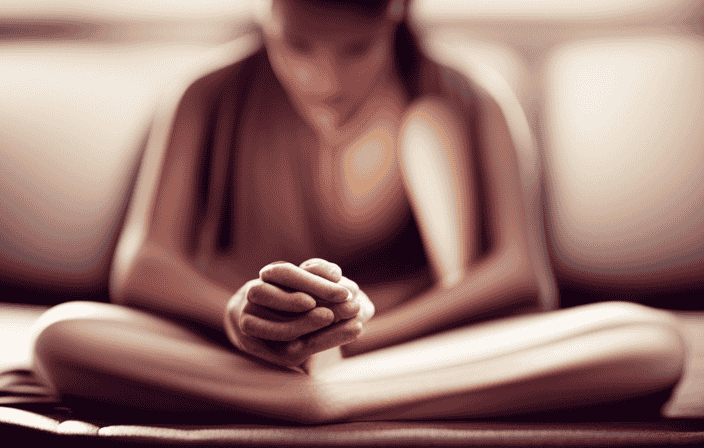
In the practice of meditation, tears are considered to be the windows to the soul, reflecting one’s innermost emotions and experiences.
Crying during meditation may seem surprising or even uncomfortable, but it is a powerful and transformative experience. In this article, we will explore the profound impact that crying can have on our emotional well-being and personal growth.
Through the release of pent-up emotions and the exploration of buried feelings, we can find healing, clarity, and inner peace. Get ready to embrace the transformative power of crying in meditation.
Key Takeaways
- Crying is a common occurrence during meditation and can signify a release of pent-up emotions.
- Crying during meditation can be a deeply transformative experience, offering an opportunity for self-awareness and growth.
- Each individual’s experience with meditation may vary, but addressing emotions can help balance and heal chakras.
- Tears symbolize a release of emotional burdens and can bring a sense of relief and clarity.
The Transformative Power
Crying during meditation has been a deeply transformative experience for me, offering the opportunity for self-awareness and growth. It is a powerful release of pent-up emotions that allows for emotional breakthroughs and healing.
As tears flow, they wash away emotional burdens and bring a sense of relief and clarity. This cathartic experience helps me confront and address suppressed feelings, creating a safe space for profound self-reflection.
Through meditation, I have learned that each individual’s experience may vary, but tears are often seen as a sign of healing. Embracing tears as a natural part of the meditation journey has allowed me to balance and heal my chakras, bringing inner peace and emotional well-being.
With the encouragement of emotional release during meditation, I have been able to explore and transform my emotions in a profound and meaningful way.
Emotional Release in Meditation
During meditation, I often experience a cathartic release of pent-up emotions. It is a powerful and transformative experience that allows me to confront and address buried emotions and unresolved trauma.
As I delve into my consciousness, these emotions surface and manifest in the form of tears. Crying during meditation is not uncommon, and it symbolizes a release of emotional burdens. It creates a safe space for me to explore and express my suppressed feelings.
Through this emotional release, I am able to find inner peace and clarity. It is a natural part of the meditation journey, and each individual’s experience may vary.
Embracing tears during meditation helps me wash away emotional baggage and promotes self-awareness and growth.
Confronting Buried Emotions
Confronting buried emotions in meditation allows me to delve into the depths of my consciousness and address unresolved trauma. During meditation, I create a safe space for these emotions to arise and be explored.
It is a transformative process that helps me gain self-awareness and promotes personal growth. Through this practice, I have come to understand that tears symbolize a release of pent-up emotions. They serve as a cathartic experience, allowing me to wash away emotional burdens and find inner peace.
Each individual’s experience may vary, as meditation acts as a powerful tool for self-reflection and confronting suppressed feelings. Embracing tears as a natural part of the meditation journey is essential, as they signify emotional breakthroughs and bring about emotional clarity and relief.
Significance of Tears
Experiencing tears during my meditation practice is a powerful way for me to release pent-up emotions and find emotional clarity. It may seem surprising, but tears have a deep significance in the meditation journey. Here are four reasons why tears are important during meditation:
-
Symbol of release: Tears often symbolize a release of pent-up emotions. They act as a natural outlet to let go of emotional burdens that have been weighing us down.
-
Sign of healing: Crying during meditation can be a sign of healing. It allows us to confront and process unresolved trauma or suppressed feelings, leading to emotional growth and self-awareness.
-
Relief and clarity: Shedding tears brings a sense of relief and emotional clarity. It washes away emotional burdens, creating space for inner peace and a renewed perspective.
-
Encouragement for emotional exploration: Meditation provides a safe space for emotions to arise and be explored. Tears are welcomed as part of the process, encouraging us to confront and address our emotions for greater balance and healing.
Incorporating tears into my meditation practice has been transformative, helping me to embrace my emotions and find a deeper sense of well-being.
Balancing and Healing Chakras
Balancing and healing my chakras through meditation has brought a sense of harmony and well-being to my life.
Chakras are energy centers in the body, and when they are balanced, it promotes physical, emotional, and spiritual health.
During meditation, I focus on each chakra, allowing any blockages or imbalances to be released.
By bringing my attention to these energy centers, I can identify and address any emotional or energetic issues that may be affecting me.
This process helps to clear stagnant energy, allowing for a greater flow of vitality and balance.
As I delve deeper into my meditation practice, I have noticed a profound shift in my overall well-being.
Balancing and healing my chakras has not only brought a sense of inner peace but has also enhanced my self-awareness and personal growth.
Self-Reflection and Growth
Through self-reflection and growth, I’ve gained a deeper understanding of myself and discovered new insights into my personal journey. It’s been a transformative experience, allowing me to confront suppressed emotions and uncover hidden aspects of my being.
Here are three key aspects of self-reflection and growth in meditation:
-
Increased self-awareness: Meditation has provided me with a safe space to explore my thoughts, feelings, and beliefs. By observing my mind and emotions without judgment, I’ve become more aware of my patterns and triggers. This self-awareness has allowed me to make conscious choices and break free from negative cycles.
-
Emotional healing: Through meditation, I’ve been able to release pent-up emotions and process unresolved trauma. Crying has been a cathartic release, washing away emotional burdens and bringing a sense of relief and clarity. It has opened the door to emotional healing and helped me move towards inner peace.
-
Personal growth: By delving into my inner world, meditation has facilitated personal growth and development. It has enabled me to challenge limiting beliefs, cultivate self-compassion, and cultivate a greater sense of purpose and meaning. Through self-reflection, I’ve gained valuable insights into myself and have grown in ways I never thought possible.
In conclusion, self-reflection and growth in meditation have been instrumental in my personal journey, fostering self-awareness, emotional healing, and personal growth.
Differing Experiences
While meditating, I have found that individuals have unique and varied experiences. Each person’s journey into their consciousness will be different, and the emotions they encounter during meditation can vary greatly.
Some may experience a sense of calm and tranquility, while others may confront intense feelings of sadness or anger. It is important to remember that there is no right or wrong experience during meditation, as it is a deeply personal practice.
Through meditation, we are able to tap into our subconscious mind and confront suppressed emotions. This process can lead to a greater sense of self-awareness and healing. By creating a safe space for emotions to arise, meditation allows us to explore and release these feelings, ultimately leading to personal growth and transformation.
Creating a Safe Space
In my personal experience, I have found that meditation provides a nurturing environment where I can explore and embrace my emotions. It creates a safe space for me to delve into my suppressed feelings and confront them head-on.
During meditation, I have discovered that tears are welcomed as a natural part of the process. They symbolize a release of pent-up emotions and help wash away emotional burdens. This emotional release has been transformative for me, allowing me to gain self-awareness and grow on a deeper level.
Research supports the idea that meditation acts as a powerful tool for self-reflection and healing. It encourages the exploration of suppressed emotions and provides a space for profound self-awareness.
Overall, meditation has been instrumental in creating a safe space for me to fully embrace and process my emotions.
Frequently Asked Questions
Can crying during meditation be harmful or indicate a mental health issue?
Crying during meditation is not harmful and does not necessarily indicate a mental health issue. It is a natural release of emotions and can be a sign of healing and emotional clarity.
How can I differentiate between releasing emotions during meditation and simply feeling overwhelmed?
Differentiating between releasing emotions during meditation and feeling overwhelmed can be challenging. Pay attention to the intensity and duration of the emotions, their connection to specific experiences, and whether they bring a sense of relief or clarity. Seek guidance from a meditation teacher or therapist if needed.
Are there any specific meditation techniques or practices that are more likely to elicit emotional release?
Some meditation techniques, such as mindfulness and loving-kindness meditation, can be more likely to elicit emotional release. These practices create a safe space for emotions to arise and allow for the exploration and release of suppressed feelings.
What can I do if I feel resistance or discomfort when emotions arise during meditation?
If I feel resistance or discomfort when emotions arise during meditation, I can try acknowledging and accepting those feelings without judgment. I can also explore gentle techniques like deep breathing or grounding exercises to help ease the discomfort.
Can crying during meditation have any physical benefits or effects on the body?
Crying during meditation can have physical benefits. It activates the parasympathetic nervous system, reducing stress and promoting relaxation. It also releases endorphins, providing pain relief and boosting mood.
Meet Nadi, the soulful writer and explorer of inner realms who graces OurMindAndBody.com with her profound insights and heartfelt wisdom. With a profound passion for mindfulness, meditation, and spiritual growth, Nadi weaves words that touch the hearts and minds of readers, leaving a lasting impact on their well-being journey.
Rooted in a background of philosophy and psychology, Nadi’s curiosity about the human mind and the mysteries of the soul led her on a transformative path of self-discovery. Drawn to the transformative power of mindfulness and meditation, she embarked on a quest to understand the intricacies of these practices, not only for her own growth but also to inspire others to embark on their own inner journeys.
-

 Aura2 months ago
Aura2 months agoUnderstanding The Grey Aura: Balance, Neutrality, And Personal Growth
-

 Personal Growth3 months ago
Personal Growth3 months agoThe Power Of Kindness: Cultivating Happiness, Connection, And Personal Growth
-

 Meditation1 month ago
Meditation1 month agoUnderstanding Spiritual Attacks: Types, Signs, And Protection
-
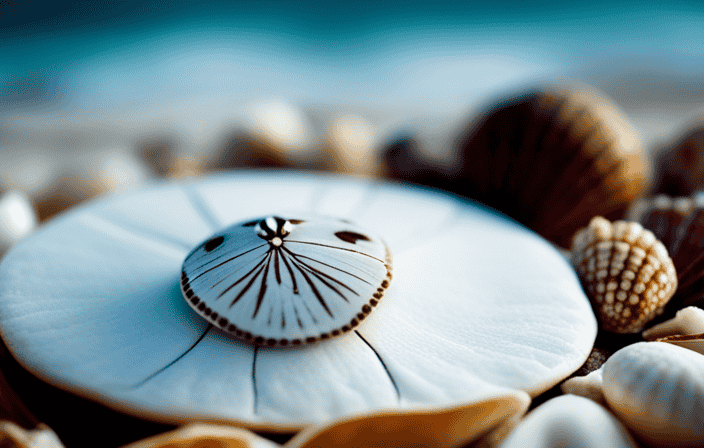
 Meditation2 months ago
Meditation2 months agoThe Symbolic Significance Of Sand Dollar: Spiritual Meanings And Cultural Connections
-

 Inspiration1 month ago
Inspiration1 month agoThe Power Of Spiritual Impartation: Empowering Believers And Cultivating Growth
-

 Inspiration3 months ago
Inspiration3 months agoThe Role And Qualities Of A Spiritual Advisor: A Guide On The Path
-

 Spirituality2 weeks ago
Spirituality2 weeks agoThe Power Of Spiritual Connection: Definition, Importance, And Ways To Achieve
-

 Spirituality2 weeks ago
Spirituality2 weeks agoThe Power Of Spiritual Cleansing: History, Benefits, Techniques, And Personal Experiences












